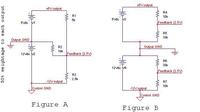electrophysics
Member level 3
Hi,
if we are designing a power supply having both positive as well as negative outputs w.r.t output ground. what technique is used to sense outputs if we want to take feedback from all negative and positive voltages at outputs in this multiple output power supply.
if we are designing a power supply having both positive as well as negative outputs w.r.t output ground. what technique is used to sense outputs if we want to take feedback from all negative and positive voltages at outputs in this multiple output power supply.

